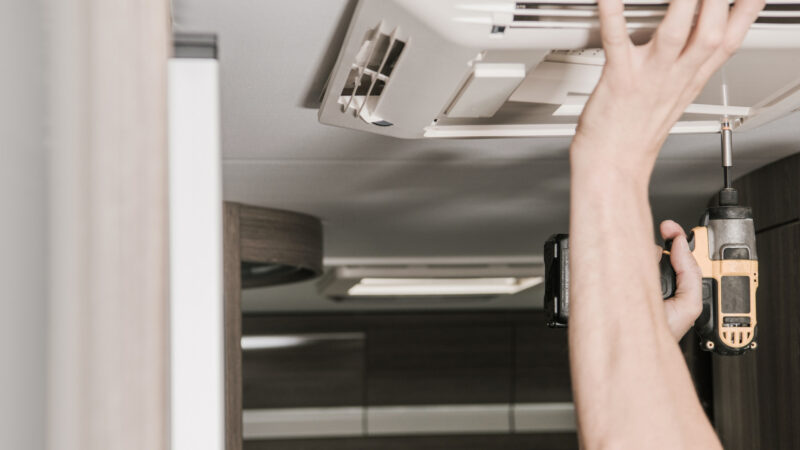Table of Contents Show
Tired of running your RV’s air conditioning unit 24/7 when your rig is hot inside?
There is a way to minimize the runtime of your A/C and still maintain a consistent, comfortable temperature by increasing your RV airflow.
How? It’s the RV Airflow System. But does it work? That’s what we wanted to know, so we found out and are here to share the results. Read on to see if you can increase your A/C’s airflow, make it quieter, and save money.
Let’s dive in!
What is the RV Airflow System?
The RV Airflow System is a piece of equipment that installs into your RV’s air conditioning unit in the space between the unit and the cover plate.
It improves airflow by capturing 100% of the air the A/C unit discharges and directs it into the RV ductwork.
RV Airflow Systems claims that its non-electrical, non-mechanical module increases airflow by an average of 40%.
Who Owns RV Airflow Systems?
Richard and Joanne Stark founded RV Airflow Systems. It was an idea born out of necessity.
Richard and Joanne are happily married RV enthusiasts. They were in their rig one hot summer day in eastern Texas. Despite running all three of their RV’s air conditioning units, they couldn’t get the temperature below 86 degrees.
They wanted to remain a happily married couple. So, tapping into his 30-plus years in the appliance industry, Richard diagnosed the issue. Once he figured out why their A/C units weren’t cooling well, he invented the RV Airflow System, which fixed the problem.
Realizing that this invention could help other RVers with their cooling needs, Richard and Joanne founded RV Airflow Systems, LLC.

How Does the RV Airflow System Work?
The RV Airflow System is an ingeniously-designed module that improves your RV air-conditioning experience.
The module installs into the plenum (the space between the A/C unit and the cover plate). It captures 100% of the discharged air and smoothly directs it into existing ductwork.
A stock air conditioning unit creates turbulence that interferes with the smooth flow of air into the RV ductwork, reducing airflow into the cabin.
The system fixes this issue without using any electricity or mechanical parts. It removes friction and turbulence to ensure your roof-mounted A/C operates at peak performance. It also reduces the noise the A/C unit generates.
What Types of RVs is the RV Airflow System Compatible With?
The RV Airflow System is compatible with more than 100 RVs. The company has verified its compatibility and has an extensive list of models on its website.
Beyond the current list, RV Airflow Systems says it works toward compatibility for all RVs on the market. That’s a tall order.
However, if you don’t see your model on the list, you can contact RV Airflow Systems, and they will check to see if they can modify their kit to fit your A/C unit’s plenum.
Not only that, but the company also lists instructions on its compatibility page so that you can measure your plenum and check the location of your ductwork. This allows you to verify compatibility before placing an order.
Keep in Mind: Looking to make life on the road easier? Then you need to make these 5 easy upgrades to your RV
What Are Customers Saying About the RV Airflow?
All that sounds excellent, but does it work in the real world? Many folks have installed the system and provided feedback on their experiences. The responses are overwhelmingly positive.
“I ordered immediately and installed the RV Airflow on my GE A/C unit and I was shocked!
The noise reduction is equally important and impressive as the strong flow of cold air coming out of all four ceiling ducts! All four A/C ducts had equal air flow and was easily over 40% stronger!” said a user named Ryan via the RV Airflow Systems website.
Kermit, in another RV Airflow Systems website review, said, “My single A/C unit in my 33′ Class C is doing a respectable job of keeping us comfortable here in Central Florida with mid 90° temps and 105°+ heat indices. I believe this is due to my ‘creative’ installation of your RV Airflow system.”
Of course, the company probably isn’t going to put bad reviews on its site. However, even on other websites and forums, the feedback is immensely positive.
“I like it for two reasons, it lowered the decibel rate in the living area from 75 to 68 [so] now the TV volume can be lower and if you don’t like running the bedroom A/C, you only need to run one A/C. There will be so much air coming out of those vents it will mess up a good hairdo if you get too close,” wrote a user in a popular RV forum.
The only real criticism is the price. Though the cost is a relatively inexpensive $170 to $180 for most RV Airflow Systems kits, a few folks tried to copy the patent-pending design by purchasing less expensive materials in a big box store and cobbling their version.
Does the System Actually Work?
The RV Airflow System works. At least, it works for the intended application.
You’ll need an RV with an air conditioning unit that utilizes ductwork, primarily mid to larger-sized rigs. Then it will fix the crucial issue of poor airflow.
In smoothing out the turbulence that interferes with proper airflow, the RV Airflow System allows the A/C unit to operate more quietly. It also relieves some of the stress on the unit, reducing the cost to operate and likely extending its lifetime.
We couldn’t find anyone who correctly installed the RV Airflow System and said it didn’t work or live up to expectations. The only criticism was a handful of folks who felt it was too pricey for their taste.
Keep in Mind: Keep the rain out of your RV with the best RV vent covers!
Get Better Cooling With This New System
Are you tired of running your RV’s air conditioning unit 24/7 and not cooling off?
Or maybe you don’t like playing frogger, hopping from spot to spot in your rig trying to find cool air, which gets too cold while other areas remain too hot.
If you have an A/C unit that blows air through a maze of ductwork, it’s time to improve your RV airflow. That’s precisely what the RV Airflow System does and why it’s a worthy investment.
You will cool off faster and with less noise than your A/C unit’s usual volume. You’ll also reduce the run-time on your A/C unit, which keeps the dials on the electric meter from spinning so much.
Our only question is: Why didn’t RV and air conditioner manufacturers think of this in the first place? It took the ingenuity of a passionate RVing couple to help us all receive better cooling.






